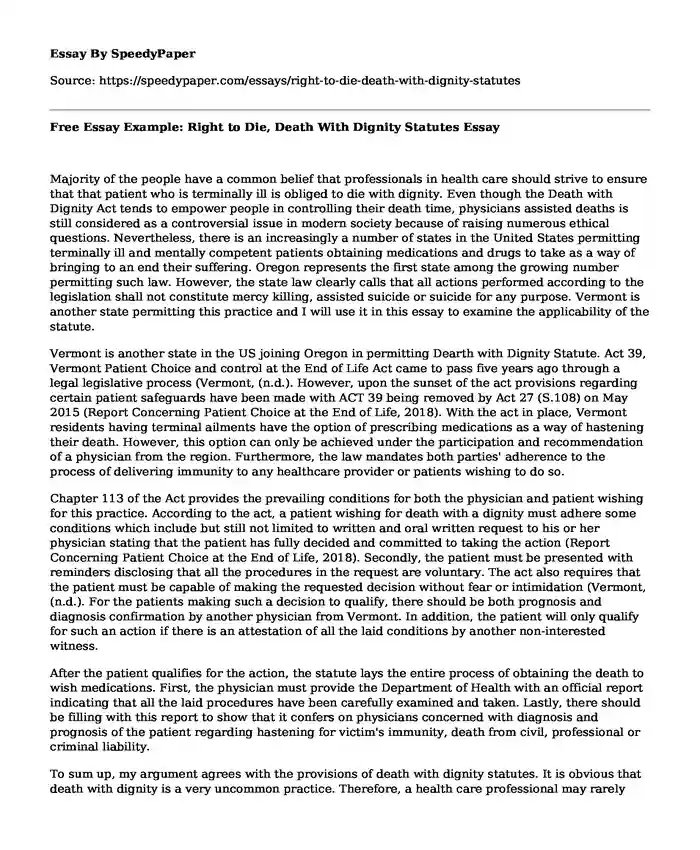
| Type of paper: | Research paper |
| Categories: | Medicine Ethical dilemma Human rights Social issue |
| Pages: | 3 |
| Wordcount: | 667 words |
Majority of the people have a common belief that professionals in health care should strive to ensure that that patient who is terminally ill is obliged to die with dignity. Even though the Death with Dignity Act tends to empower people in controlling their death time, physicians assisted deaths is still considered as a controversial issue in modern society because of raising numerous ethical questions. Nevertheless, there is an increasingly a number of states in the United States permitting terminally ill and mentally competent patients obtaining medications and drugs to take as a way of bringing to an end their suffering. Oregon represents the first state among the growing number permitting such law. However, the state law clearly calls that all actions performed according to the legislation shall not constitute mercy killing, assisted suicide or suicide for any purpose. Vermont is another state permitting this practice and I will use it in this essay to examine the applicability of the statute.
Vermont is another state in the US joining Oregon in permitting Dearth with Dignity Statute. Act 39, Vermont Patient Choice and control at the End of Life Act came to pass five years ago through a legal legislative process (Vermont, (n.d.). However, upon the sunset of the act provisions regarding certain patient safeguards have been made with ACT 39 being removed by Act 27 (S.108) on May 2015 (Report Concerning Patient Choice at the End of Life, 2018). With the act in place, Vermont residents having terminal ailments have the option of prescribing medications as a way of hastening their death. However, this option can only be achieved under the participation and recommendation of a physician from the region. Furthermore, the law mandates both parties' adherence to the process of delivering immunity to any healthcare provider or patients wishing to do so.
Chapter 113 of the Act provides the prevailing conditions for both the physician and patient wishing for this practice. According to the act, a patient wishing for death with a dignity must adhere some conditions which include but still not limited to written and oral written request to his or her physician stating that the patient has fully decided and committed to taking the action (Report Concerning Patient Choice at the End of Life, 2018). Secondly, the patient must be presented with reminders disclosing that all the procedures in the request are voluntary. The act also requires that the patient must be capable of making the requested decision without fear or intimidation (Vermont, (n.d.). For the patients making such a decision to qualify, there should be both prognosis and diagnosis confirmation by another physician from Vermont. In addition, the patient will only qualify for such an action if there is an attestation of all the laid conditions by another non-interested witness.
After the patient qualifies for the action, the statute lays the entire process of obtaining the death to wish medications. First, the physician must provide the Department of Health with an official report indicating that all the laid procedures have been carefully examined and taken. Lastly, there should be filling with this report to show that it confers on physicians concerned with diagnosis and prognosis of the patient regarding hastening for victim's immunity, death from civil, professional or criminal liability.
To sum up, my argument agrees with the provisions of death with dignity statutes. It is obvious that death with dignity is a very uncommon practice. Therefore, a health care professional may rarely come across this situation. Besides, there are ultimately fewer cases less than 52 cases of death with dignity incidences since the passage of the Vermont death act. Besides the 52 people wishing, 48 claims have been filed with the department. This means that the physicians are adequately trained to distinguish a condition that qualifies a terminally ill patient to hasten death or not.
References
Report Concerning Patient Choice at the End of Life. (n.d.). Retrieved from https://legislature.vermont.gov/assets/Legislative-Reports/2018-Patient-Choice-Legislative-Report-12-14-17.pdf
Vermont. (n.d.). Retrieved from https://www.deathwithdignity.org/states/vermont/
Cite this page
Free Essay Example: Right to Die, Death With Dignity Statutes. (2023, Feb 02). Retrieved from https://speedypaper.net/essays/right-to-die-death-with-dignity-statutes
Request Removal
If you are the original author of this essay and no longer wish to have it published on the SpeedyPaper website, please click below to request its removal:
- Western Civilization Essay Example
- Free Essay Example about Insomnia
- Essay Example on Solutions to Cyberbullying
- Essay Sample about Politics in America Today
- Essay Sample on impacts of the e-government on corruption across Asian countries
- Dream Career Speech Outline, Free Paper Sample for You
- Policy Analysis - Free Paper
Popular categories




